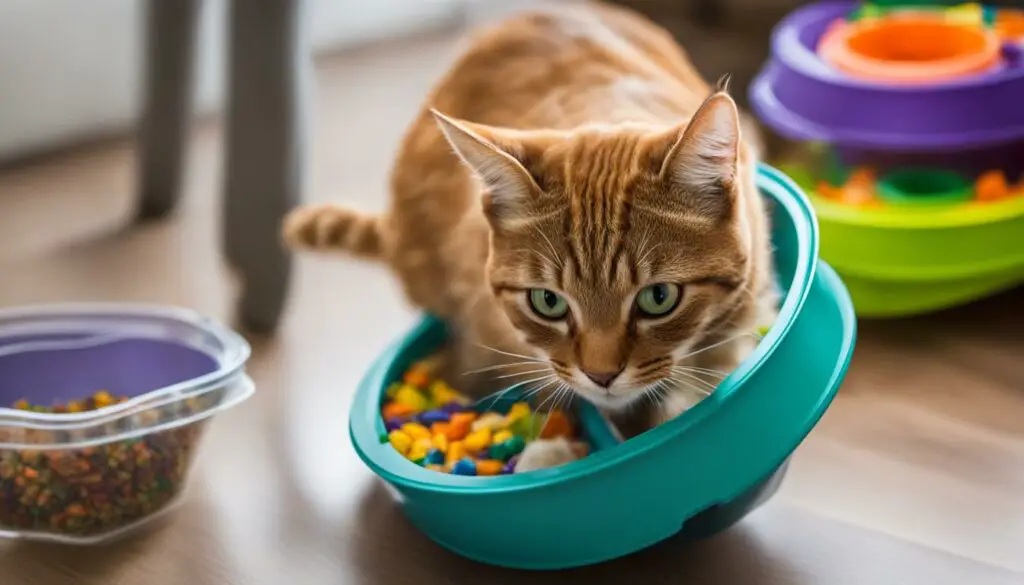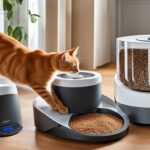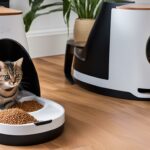Is your cat gobbling up their food too quickly? Not only can this lead to indigestion and weight gain, but it also deprives them of mental stimulation during mealtime. Luckily, there’s a solution – DIY slow feeder cat bowls!
Slow feeder systems are designed to regulate your cat’s eating pace and provide them with a fun and challenging feeding experience. By incorporating puzzle elements into their mealtime routine, you can keep your feline friend engaged and entertained. Plus, it’s a great way to repurpose household items and create homemade toys for your cat.
In this article, I’ll share with you five different DIY slow feeder cat bowl plans that you can easily create at home. Let’s dive in and make mealtime more exciting for your furry companion!
Key Takeaways:
- Create DIY slow feeder cat bowls to regulate your cat’s eating pace and provide mental stimulation.
- Repurpose household items to make homemade cat puzzles and toys.
- Try different DIY options to find the best one for your cat.
- Consider purchasing a ready-made slow feeder cat bowl like the Hepper NomNom Cat Bowl.
- Explore related articles on slow feeders for cats and other ways to improve your cat’s mealtime experience.
Easy DIY Slow-Feed Cat Bowl Using an Egg Carton
If you’re looking for a simple and budget-friendly way to slow down your cat’s eating, why not repurpose an empty egg carton? This easy DIY slow-feed cat bowl is a fun and interactive way to make mealtime last longer and provide mental stimulation for your feline friend.
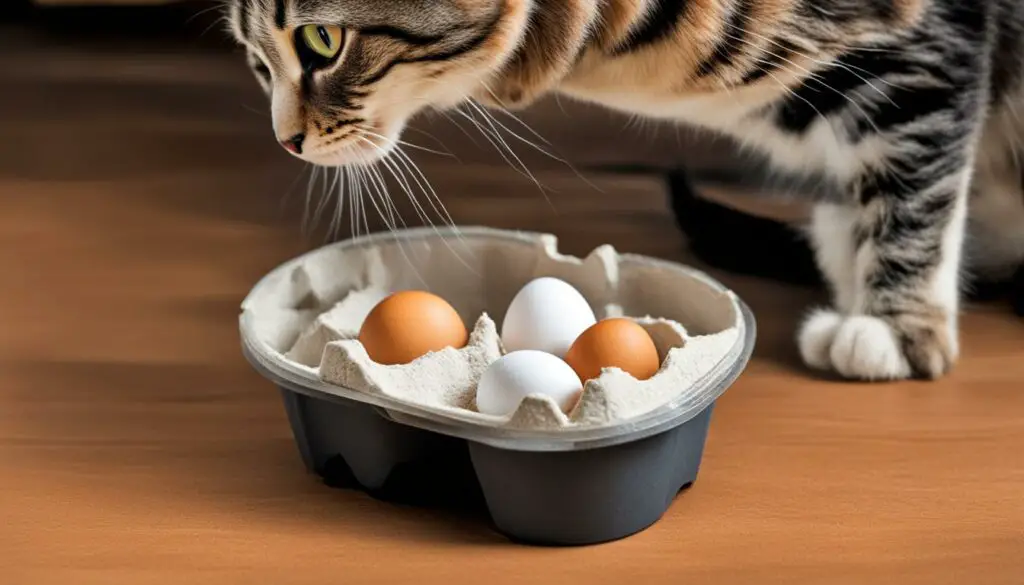
To create this slow feeder, start by opening the egg carton and removing the lid. Fill a few of the compartments with your cat’s favorite dry food or treats. The small compartments will make it more challenging for your cat to access the food, encouraging them to slow down their eating pace.
Your cat will use their paws to remove the food from the egg carton, mimicking natural hunting behaviors and making mealtime more engaging. Not only does this slow feeder help prevent indigestion and weight gain, but it also provides mental stimulation and enrichment for your cat.
DIY Puzzle Slow Feeder Using a Cardboard Box and Rolls
Looking for an inexpensive and fun way to slow down your cat’s eating habits? Why not try creating a DIY puzzle slow feeder using a cardboard box and empty toilet paper or paper towel rolls? Not only will this homemade cat puzzle provide mental stimulation for your feline friend, but it will also help regulate their eating pace.
To make this DIY puzzle slow feeder, start by cutting several holes in a sturdy cardboard box. The size of the holes should be just large enough to fit the empty rolls snugly. Next, insert the rolls into the holes, creating a maze-like structure inside the box. Finally, place small portions of your cat’s food inside each roll. As your cat tries to reach the food, they will need to navigate the rolls, slowing down their eating speed and providing a challenging yet rewarding mealtime experience.
This DIY puzzle slow feeder is not only easy to assemble but also allows for customization. You can vary the size and number of holes and rolls to suit your cat’s preferences and abilities. Additionally, you can use different types of treats or kibble to keep things interesting for your furry friend. Just remember to monitor your cat’s progress and ensure they are still able to access the food easily.
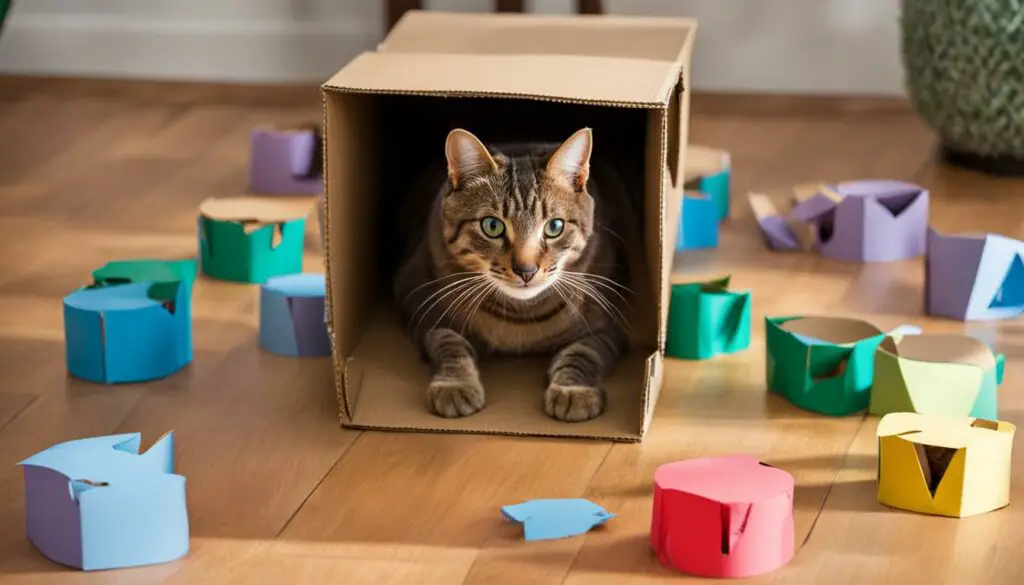
How to Make a DIY Puzzle Slow Feeder Using a Cardboard Box and Rolls:
- Cut several holes in a sturdy cardboard box.
- Insert empty toilet paper or paper towel rolls into the holes, creating a maze-like structure.
- Place small portions of food inside each roll.
- Watch as your cat navigates the rolls to access their food and enjoys a slower, more engaging mealtime.
With this DIY puzzle slow feeder, you can provide mental stimulation and encourage your cat to eat at a healthier pace. Give it a try and see how your feline friend enjoys the challenge!
Simple Slow Feeder Using Two Different-Sized Bowls
If you’re looking for a simple and effective way to slow down your cat’s eating, you can create a DIY slow feeder using two different-sized bowls. This method is easy to set up and can help regulate your cat’s eating pace, reducing the risk of indigestion and weight gain.
To make this simple slow feeder, all you need is a smaller bowl or cup and a larger bowl. Place the smaller bowl or cup upside down inside the larger bowl. Sprinkle your cat’s food around the interior dish, and watch as your cat has to work to access the food. By having to maneuver around the smaller bowl or cup, your cat will naturally slow down their eating speed.
This two-bowl slow feeder is a great option if you already have different-sized bowls at home. It provides a simple and cost-effective way to promote healthy eating habits for your feline friend.
| Benefits of Two-Bowl Slow Feeder |
|---|
| Slows down eating speed |
| Encourages mental stimulation |
| Reduces the risk of indigestion and weight gain |
| Uses common household items |
This simple DIY slow feeder is just one of the many options available to cat owners. It’s important to find a feeding method that works best for your cat’s needs and preferences. Whether you choose to make your own slow feeder or explore ready-made options, the key is to provide your cat with an enjoyable and enriching mealtime experience.
DIY Slow Feeder with a Dual Bowl Stand and Cardboard
If you’re looking for a creative and effective way to slow down your cat’s eating, try making a DIY slow feeder with a dual bowl stand and cardboard. This homemade slow feeder will provide mental stimulation and encourage your cat to eat at a slower pace, promoting better digestion and reducing the risk of overeating.
To make this DIY slow feeder, you’ll need a dual bowl stand, a feeding bowl, a piece of cardboard, an elastic band, and a plastic cup. Start by placing the feeding bowl in one of the compartments of the dual bowl stand. Then, cut a piece of cardboard to fit over the bowl, creating a barrier. Secure the cardboard in place with an elastic band, making sure it’s firmly attached. Finally, place a plastic cup on top of the cardboard, creating a small opening for your cat to access their food.
With this DIY slow feeder, your cat will have to work for each bite of food. They’ll need to use their paws to reach into the cup and retrieve the food, slowing down their eating pace. This interactive feeding experience will not only help regulate their eating speed but also provide mental stimulation, keeping them entertained during mealtimes. Remember to supervise your cat while they’re using the slow feeder to ensure their safety.
| Materials | Instructions |
|---|---|
| Dual bowl stand | 1. Place feeding bowl in one compartment of the dual bowl stand. |
| Feeding bowl | 2. Cut a piece of cardboard to fit over the bowl. |
| Piece of cardboard | 3. Secure the cardboard in place with an elastic band. |
| Elastic band | 4. Place a plastic cup on top of the cardboard. |
| Plastic cup | 5. Create a small opening for your cat to access the food. |
This DIY slow feeder with a dual bowl stand and cardboard is a simple and budget-friendly solution to help regulate your cat’s eating pace. By incorporating mental stimulation into mealtimes, you’ll not only improve their digestion but also provide an enriching experience. Give it a try and see the positive impact it can have on your cat’s mealtime routine!
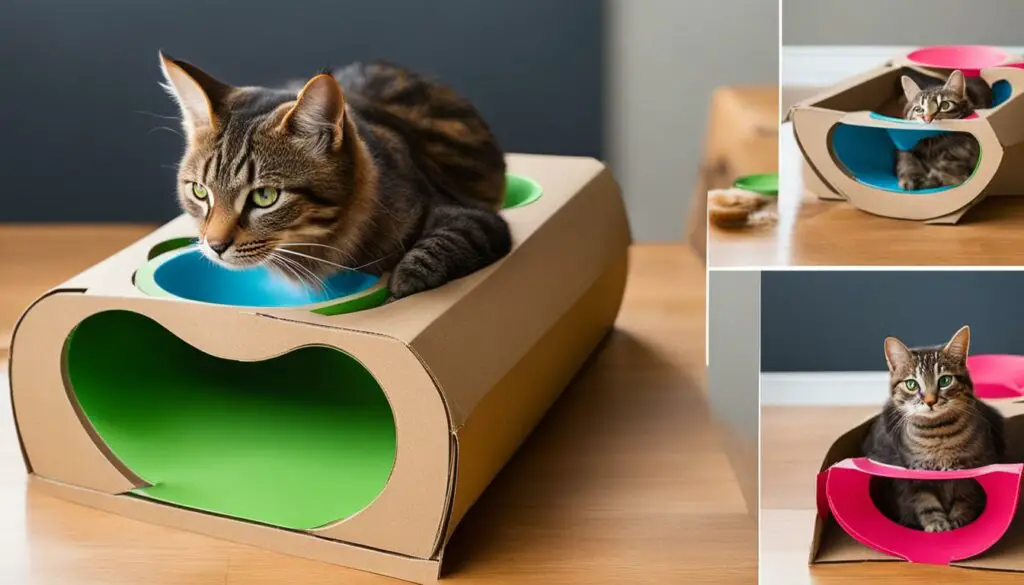
DIY Interactive Slow Feeder Using Cardboard and Magnets
If you’re looking for a fun and engaging way to slow down your cat’s eating while providing mental stimulation, try making a DIY interactive slow feeder using cardboard and magnets. This project combines a slow feeder with an interactive toy, keeping your feline friend entertained and challenged during mealtime.
To create this DIY slow feeder, you’ll need some cardboard, magnets, and wooden dowels. Start by cutting the cardboard into various shapes, such as circles, squares, or triangles. Attach magnets to the back of each cardboard shape and scatter them around the feeding area. Next, place the wooden dowels on top of the magnets, creating a barrier that your cat will need to navigate to access their food.
When your cat approaches the DIY interactive slow feeder, they’ll be drawn to the cardboard shapes. They’ll have to use their paws and problem-solving skills to remove the shapes from the magnets, revealing the food underneath. This engaging activity not only slows down your cat’s eating but also provides mental stimulation and enrichment.
Making Mealtime Fun and Challenging for Your Cat
Using a DIY interactive slow feeder can offer numerous benefits for your cat’s mealtime experience. The combination of the slow feeding mechanism and the interactive toy component engages your cat’s natural hunting instincts and encourages them to work for their food. This can help prevent digestive issues that may arise from eating too quickly and also promote healthier eating habits.
By incorporating cardboard shapes and magnets into the DIY slow feeder, you’re also providing mental stimulation and enrichment for your cat. The process of removing the shapes requires problem-solving skills and dexterity, keeping your cat entertained and engaged during mealtime. It’s a great way to provide both physical and mental exercise for your feline friend.
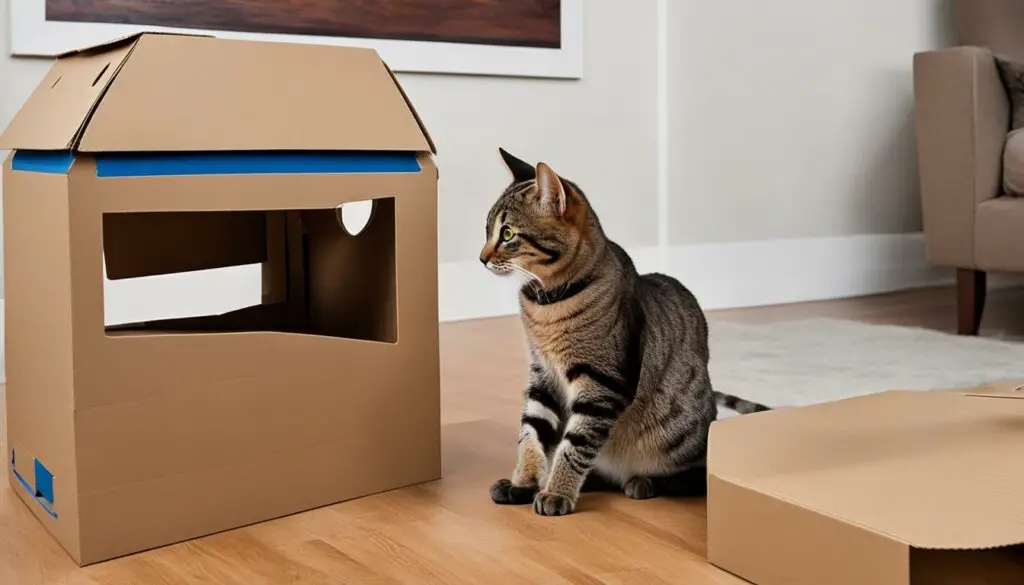
So why not give this DIY interactive slow feeder a try? It’s a creative and budget-friendly way to enhance your cat’s mealtime experience, keeping them entertained, challenged, and slowing down their eating pace. Your feline friend will thank you for the added mental stimulation and enrichment during meals!
DIY Puzzle Feeder Using an Empty Cereal Box and Rolls
If you’re looking for an inexpensive and creative way to make a puzzle feeder for your cat, look no further than your kitchen pantry. With just an empty cereal box and some cardboard rolls, you can create a DIY puzzle feeder that will provide mental stimulation and slow down your cat’s eating.
To make the puzzle feeder, start by collecting empty cereal boxes and cardboard rolls. Cut several holes in the top of the cereal box, large enough for the rolls to fit snugly inside. Place the rolls into the holes, making sure they are secure. Then, fill each roll with kibble or treats. Close the flaps of the cereal box, ensuring that the rolls are hidden inside.
Once the puzzle feeder is ready, present it to your cat and watch as they discover the challenge. Your cat will have to figure out how to retrieve the treats or dinner from the box by using their paws to manipulate the rolls. This engaging activity will not only slow down their eating but also provide mental stimulation, keeping them entertained for longer periods.
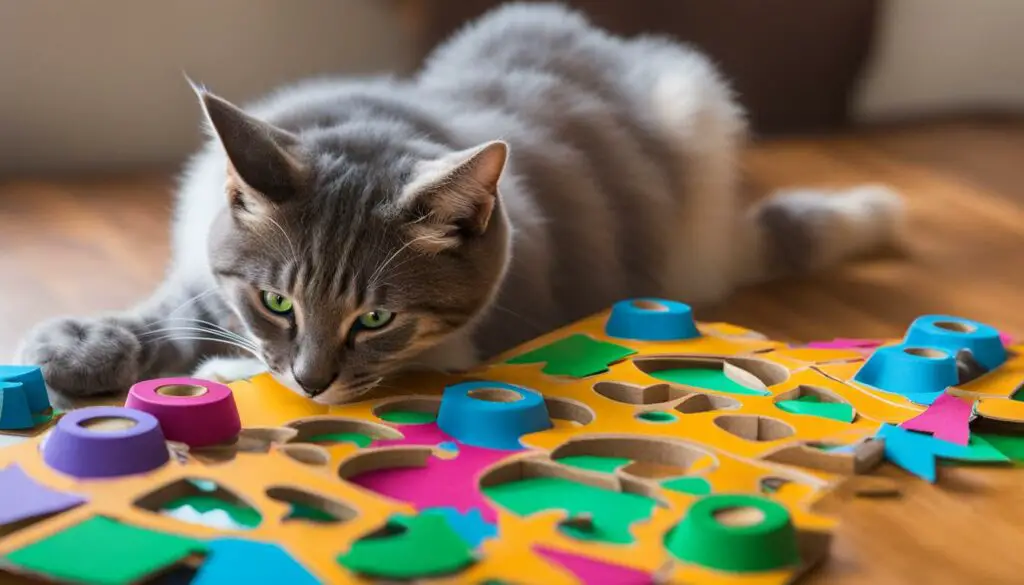
Create a DIY Puzzle Feeder Using an Empty Cereal Box and Rolls
A DIY puzzle feeder is a fantastic way to engage your cat during mealtime and slow down their eating pace. This homemade feeding solution can be easily created using materials found around your home. Plus, it adds an element of fun and mental stimulation to your cat’s daily routine.
To create your own DIY puzzle feeder, you will need empty cereal boxes and cardboard rolls. Begin by cutting holes in the top of the cereal box, large enough for the cardboard rolls to fit inside. Insert the rolls, making sure they are secure. Fill each roll with your cat’s favorite treats or kibble. Then, close the flaps of the cereal box to hide the rolls.
Present the puzzle feeder to your cat and watch as they discover the challenge of retrieving the treats from the box. They will use their paws to manipulate the rolls, slowing down their eating and providing mental stimulation. Not only will this DIY puzzle feeder help regulate your cat’s eating pace, but it will also keep them entertained and engaged during mealtime.
Advantages of a DIY Puzzle Feeder
A DIY puzzle feeder offers several advantages for both you and your cat. Firstly, it is a cost-effective solution, as it utilizes materials that you may already have at home. Secondly, it provides mental stimulation for your cat, keeping them engaged and entertained during mealtime. Thirdly, the puzzle feeder helps slow down your cat’s eating speed, reducing the risk of indigestion and weight gain. Lastly, creating a DIY puzzle feeder allows you to customize the design and difficulty level to suit your cat’s needs and preferences.
| Advantages of a DIY Puzzle Feeder |
|---|
| Cost-effective solution |
| Provides mental stimulation |
| Slows down eating speed |
| Customizable design and difficulty level |
Easy Slow Feeder Using a Muffin Tin
If you’re looking for a simple and effective DIY slow feeder for your cat, repurposing an old muffin tin is a great option. Not only is it easy to create, but it also provides a fun and engaging mealtime experience for your feline companion.
To make a muffin tin slow feeder, start by distributing your cat’s dinner randomly throughout the cups. This encourages your cat to actively search for their food, slowing down their eating pace. You can use kibble or small treats as the food source, depending on your cat’s preferences.
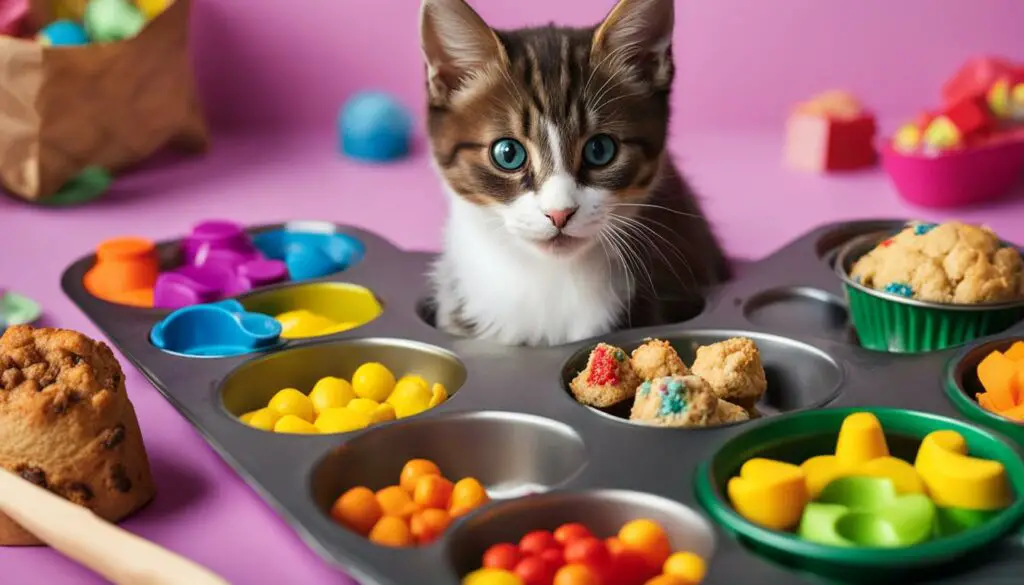
The muffin tin slow feeder is especially useful for cats who tend to gobble up their food too quickly. By making them work a little harder for their meal, you can help prevent digestive issues and promote healthier eating habits. Plus, it’s a simple and cost-effective alternative to ready-made slow feeder devices.
DIY Slow Feeder Using a Coffee Mug and Placemat
Looking for a creative way to slow down your cat’s eating? Try making a DIY slow feeder using a coffee mug and placemat. This simple and inventive solution will not only help regulate your cat’s eating pace but also provide an enjoyable mealtime experience.
Here’s how you can create your own coffee mug slow feeder:
- Start by selecting a coffee mug with a wide opening. This will allow your cat to easily access the food inside.
- Place a waterproof placemat on the floor to catch any spills or messes. This will help keep your feeding area clean and tidy.
- Fill the coffee mug with wet food or a mixture of wet and dry food. Wet food works particularly well in this type of slow feeder as your cat will need to use their paws to extract the food from the mug.
- Set the coffee mug on the placemat and watch as your cat engages in a problem-solving activity to retrieve their food.
This DIY slow feeder provides mental stimulation for your cat as they work to extract their food from the coffee mug. It also helps slow down their eating pace, reducing the risk of indigestion and weight gain. Keep in mind that wet food may require more cleaning and maintenance compared to dry food, so be sure to wash the coffee mug and placemat regularly.
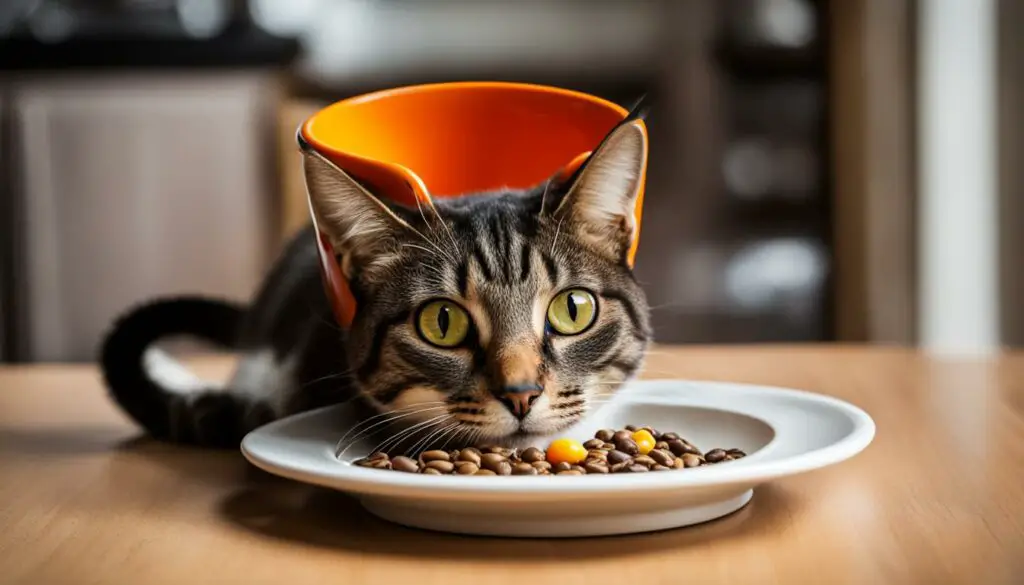
Benefits of a Coffee Mug Slow Feeder
Using a coffee mug as a slow feeder offers several benefits for your cat:
- Mental Stimulation: The interactive nature of the coffee mug slow feeder engages your cat’s mind, providing mental stimulation during mealtime.
- Portion Control: By slowing down your cat’s eating pace, the coffee mug slow feeder helps with portion control, preventing them from overeating.
- Prevents Gulping: Cats who eat too quickly are prone to gulping, which can lead to indigestion and other digestive issues. The coffee mug slow feeder encourages them to eat at a slower pace, reducing the risk of these problems.
- Fun and Enjoyable: The coffee mug slow feeder turns mealtime into an exciting and enjoyable activity for your cat, adding a sense of enrichment to their daily routine.
Try making your own coffee mug slow feeder and see how it enhances your cat’s mealtime experience. It’s a simple and creative way to provide mental stimulation and regulate your cat’s eating pace.
DIY Slow Feeder Using a Toilet Paper Roll
When it comes to creating a DIY slow feeder for your cat, even a simple household item like a toilet paper roll can do the trick. This budget-friendly option provides mental stimulation and encourages your cat to eat at a slower pace. By repurposing the cardboard roll, you can create a fun and interactive feeding experience for your feline friend.
To create the slow feeder, start by cutting a small hole in the side of the toilet paper roll. This hole should be big enough for your cat to reach their paw inside. Next, fill the roll with your cat’s favorite treats or dry food. Fold the ends of the roll to keep the food securely inside. Now, place the roll in your cat’s feeding area and watch as they use their paws to retrieve the treats, effectively slowing down their eating speed.
The DIY slow feeder using a toilet paper roll is not only easy to make but also provides a great solution for cats who tend to eat too quickly. It engages their natural instincts to hunt and forage for food, making mealtime more enjoyable and mentally stimulating. Give it a try and see how your cat responds to this simple yet effective feeding puzzle.
DIY Slow Feeder Using a Toilet Paper Roll: Step-by-Step Instructions
- Cut a small hole in the side of a toilet paper roll.
- Fill the roll with your cat’s favorite treats or dry food.
- Fold the ends of the roll to secure the food inside.
- Place the roll in your cat’s feeding area.
- Watch as your cat uses their paws to retrieve the treats or food, slowing down their eating speed.
With just a toilet paper roll, you can create an engaging DIY slow feeder for your cat. This simple and affordable solution not only slows down your cat’s eating pace but also provides mental stimulation and enriches their mealtime experience. Give it a try and see how it benefits your feline companion.
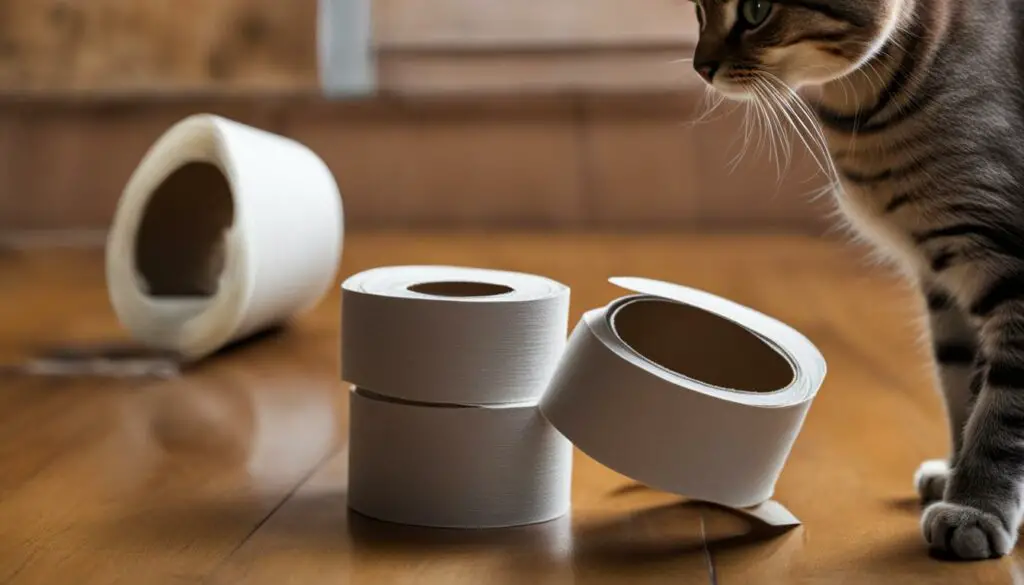
Opt for a Practical and Modern Slow Feeder Cat Bowl
If you’re looking for a convenient and contemporary solution to slow down your cat’s eating habits, consider investing in a practical and modern slow feeder cat bowl. While DIY options are fun and creative, a ready-made slow feeder can offer several advantages in terms of design and ease of use.
One excellent option is the Hepper NomNom Cat Bowl. This innovative slow feeder features shallow stainless steel bowls that promote healthier eating posture and reduce whisker fatigue. The elevated base adds comfort for your cat while eating, and the wrap-around tray catches any spills, making it easy to clean up after mealtime.
Designed with both you and your feline friend in mind, the Hepper NomNom Cat Bowl combines functionality with aesthetic appeal. Its sleek and modern design will seamlessly fit into any home decor, while its practical features ensure a stress-free feeding experience for both you and your cat.

Investing in a practical and modern slow feeder cat bowl like the Hepper NomNom Cat Bowl is a great way to improve your cat’s mealtime routine. Not only will it help regulate their eating speed and prevent indigestion, but it will also provide mental stimulation and enrichment. Give your cat the gift of a healthier and more enjoyable mealtime with a modern slow feeder cat bowl.
Conclusion
DIY slow feeder cat bowls provide a practical and cost-effective solution for cats who eat too quickly. These homemade slow feeders not only help regulate their eating pace but also provide mental stimulation, promoting a healthier and more enjoyable mealtime experience for your feline friend.
Whether you repurpose household items like egg cartons, cardboard boxes, or muffin tins, or opt for more complex DIY projects using magnets or wooden dowels, there are numerous ways to create engaging slow feeders for your cat. Each option presents a unique challenge that encourages your cat to work for their food, slowing down their eating and promoting better digestion.
By incorporating DIY slow feeders into your cat’s routine, you can enrich their mealtime and provide them with additional mental stimulation. Additionally, these homemade slow feeders allow you to customize the design and difficulty level based on your cat’s individual needs and preferences. Experiment with different options until you find the best fit for your furry friend.
Related Reads
If you’re interested in learning more about slow feeders for cats and exploring alternative cat bowl options, check out the related articles below:
1. “The Benefits of Slow Feeders for Cats”
Discover the advantages of using slow feeders for cats and how they can improve your feline friend’s eating habits and overall well-being. This article provides insights into the various types of slow feeders available and their impact on cats’ mental and physical health.
2. “Cat Bowl Alternatives: Thinking Outside the Bowl”
Explore innovative cat bowl alternatives that can enhance your cat’s mealtime experience. From puzzle feeders to interactive toys, this article offers creative solutions to make feeding time more engaging and mentally stimulating for your feline companion.
3. “DIY Enrichment Toys for Cats”
If you enjoy crafting and engaging in DIY projects, this article provides step-by-step instructions for creating homemade enrichment toys for cats. These toys can help stimulate your cat’s natural instincts and provide mental and physical exercise.
Please note that the content of these articles may vary, but they all provide valuable information and insights on slow feeders for cats and alternative feeding options. Happy reading and exploring!
Buy a Ready-Made Slow Feeder
If you’re not the DIY type or simply prefer a ready-made solution, there are plenty of options available for slow feeder cat bowls. One popular choice is the Hepper NomNom Cat Bowl.
The Hepper NomNom Cat Bowl is specifically designed to improve your cat’s eating habits and overall health. With its shallow stainless steel bowls, it helps slow down your cat’s eating speed and reduce the risk of indigestion and weight gain. The elevated base promotes a more comfortable feeding position, while the wrap-around tray catches any spills for easy cleaning.
The Hepper NomNom Cat Bowl is not only practical but also aesthetically pleasing, with a modern design that fits seamlessly into your home decor. It is dishwasher-safe, making it convenient to keep clean and hygienic for your feline friend. So if you’re looking for a hassle-free solution to make mealtime fun and healthy for your cat, the Hepper NomNom Cat Bowl is definitely worth considering.
FAQ
Why should I use a slow feeder for my cat?
Cats who eat too quickly can experience indigestion and weight gain. Slow feeder systems can help regulate their eating pace and provide mental stimulation.
What are some DIY slow feeder cat bowl plans I can try?
Here are five DIY slow feeder cat bowl plans to try:
- An empty egg carton
- A cardboard box and empty toilet paper or paper towel rolls
- Two different-sized feeding dishes
- A dual bowl stand, a piece of cardboard, an elastic band, and a plastic cup
- Cardboard, magnets, and wooden dowels
How do I make a slow feeder using an egg carton?
Simply open the carton and pour some food into a few compartments. Your cat will use their paws to remove the pieces of food, slowing down their eating speed.
How do I make a puzzle slow feeder using a cardboard box and rolls?
Cut holes in the box, insert the rolls, and place food inside them. Your cat will have to work to get the food out, providing mental stimulation and slowing down their eating.
How do I make a simple slow feeder using two different-sized bowls?
Place a smaller bowl or cup upside down inside a larger bowl. Sprinkle food around the interior dish, and your cat will have to work to access the food, reducing their eating speed.
How do I make a DIY slow feeder with a dual bowl stand and cardboard?
Create a barrier in the feeding bowl using a piece of cardboard and a plastic cup. Your cat will have to work for each bite of food.
How do I make a DIY interactive slow feeder using cardboard and magnets?
Using cardboard, magnets, and wooden dowels, you can create a contraption that requires your cat to interact and problem-solve to access their food.
How do I make a DIY puzzle feeder using an empty cereal box and rolls?
Place kibble inside the rolls, tuck them into the cereal box, and close the flaps. Your cat will have to figure out how to retrieve the treats or dinner from the box.
How do I make an easy slow feeder using a muffin tin?
Distribute your cat’s dinner randomly throughout the cups of an old muffin tin, encouraging them to actively search for their food and slowing down their eating.
How do I make a DIY slow feeder using a coffee mug and placemat?
Place wet food in the mug, and your cat will need to use their paws to extract the food, providing a problem-solving activity and slowing their eating speed.
How do I make a DIY slow feeder using a toilet paper roll?
After finishing a roll of toilet paper, cut a hole in the cardboard core, add treats or dry food, and fold the ends to keep the treats inside. Your cat will need to use their paws to retrieve the food, providing mental stimulation.
Where can I buy a ready-made slow feeder cat bowl?
You can purchase a ready-made slow feeder cat bowl like the Hepper NomNom Cat Bowl. It features a practical design and is dishwasher-safe for easy cleaning.
Source Links
- https://www.hepper.com/diy-slow-feed-cat-bowl-plans/
- https://outwardhound.com/furtropolis/cats/cat-eats-too-fast
- https://petkeen.com/diy-slow-feed-cat-bowls/

